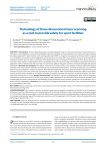Safety of buildings and facilities. Рубрика в журнале - Nanotechnologies in Construction: A Scientific Internet-Journal

Technology of three-dimensional laser scanning as a tool to provide safety for sport facilities
Статья научная
Introduction. Human safety during sport activities depends mostly on the technical states of sport facilities. According to current legislation, every school and higher education institution with sport facilities must meet nationwide standards for safety requirements. Sports facilities with existing codes and GOSTR are inspected by a special committee, which is required for accreditation, and which has been applied for several decades. This study offers more accurate and up-to-date methods for inspection of these sport facilities, specifically three-dimensional laser scanning. The technology of three-dimensional laser scanning is used mainly to obtain high precision and detailed measurements of any object. The authors analyzed the methods of application of three-dimensional laser scanning to assure human safety during sport activities at schools and higher educational institutions. Materials and methods. The objects analyzed were running tracks at the stadium at Kuban State Technological University. The main research method is an empirical one, namely field measurements. Scanning of racetracks was performed with the Leica ScanStation C10 from six stations. After field measurements were taken, point cloud was imported into special software to process the results of the laser scanning by the Leica Cyclone. After measurements were taken, all the critical points of the racetracks were classified by the height. According to existing standards for racetracks at athletic stadiums, the allowable value of roughness is 10 mm. Results and discussion. Classification of points revealed that the limit value for roughness of University’s racetrack was 9 mm (which meets existing safety requirements for racetracks). Thus, racetracks of Kuban State Technological University underwent the accreditation process performed by the research group from the Department of Cadaster and Geo-Engineering. Conclusion. The conclusion of the paper detertmined that, in fact, laser scanning can be applied to control safety of race tracks.
Бесплатно

